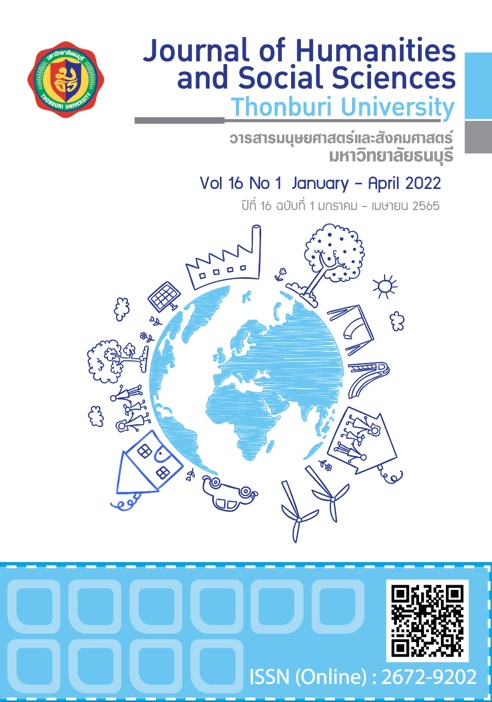ปัจจัยเชิงเหตุและผลของความยึดมั่นผูกพันในงานที่มีต่อพฤติกรรมมุ่งนวัตกรรม ของอาจารย์ มหาวิทยาลัยเกษตรศาสตร์
คำสำคัญ:
พฤติกรรมมุ่งนวัตกรรม, ความยึดมั่นผูกพันในงาน, บรรยากาศการทำงานแบบสร้างสรรค์, ทุนทางจิตวิทยา, บุคลิกภาพเชิงรุกบทคัดย่อ
การวิจัยครั้งนี้ มีวัตถุประสงค์เพื่อตรวจสอบความสอดคล้องของแบบจำลองปัจจัยเชิงเหตุและผลของความยึดมั่นผูกพันในงานที่มีต่อพฤติกรรมมุ่งนวัตกรรมของอาจารย์มหาวิทยาลัยเกษตรศาสตร์ที่พัฒนาขึ้นกับข้อมูลเชิงประจักษ์ ใช้แบบสอบถามในการเก็บข้อมูลจากกลุ่มตัวอย่างอาจารย์มหาวิทยาลัยเกษตรศาสตร์ จำนวน 381 คน ผลการวิจัยพบว่า (1) แบบจำลองหลังจากการปรับมีความสอดคล้องกับข้อมูลเชิงประจักษ์ มีค่าสถิติ c ²= 30.40 p-value = .17 GFI = .99 AGFI = .95 SRMR = .02 RMSEA = .00 และมีค่า CN = 538.25 โดยทุนทางจิตวิทยา บุคลิกภาพเชิงรุก บรรยากาศการทำงานแบบสร้างสรรค์ และความยึดมั่นผูกพันในงานสามารถร่วมกันอธิบายความแปรปรวนของพฤติกรรมมุ่งนวัตกรรมได้ 79% (2) ทุนทางจิตวิทยา บุคลิกภาพเชิงรุก บรรยากาศการทำงานแบบสร้างสรรค์ และความยึดมั่นผูกพันในงานมีอิทธิพลทางตรงต่อพฤติกรรมมุ่งนวัตกรรม (3) ทุนทางจิตวิทยาและบรรยากาศการทำงานแบบสร้างสรรค์มีอิทธิพลทางอ้อมต่อพฤติกรรมมุ่งนวัตกรรมผ่านความยึดมั่นผูกพันในงาน
References
กองการเจ้าหน้าที่ มหาวิทยาลัยเกษตรศาสตร์. (2563). จำนวนบุคลากรจำแนกตามวิทยาเขตและประเภทตำแหน่งประจำเดือนมกราคม 2563. สืบค้นเมื่อ 6 มกราคม 2563, จาก www.person.ku.ac.th/new_personweb/stat.php.
เกียรติสุดา ศรีสุข. (2552). ระเบียบวิธีวิจัย. เชียงใหม่: โรงพิมพ์ครองช่าง.
ชลกร ตันประภัสร์, ธร สุนทรายุทธ และ ไพรัตน์ วงษ์นาม. (2556). ปัจจัยที่ส่งผลต่อความสร้างสรรค์และนวัตกรรมของโรงเรียนเอกชน ประเภทสามัญศึกษา ระดับการศึกษาขั้นพื้นฐาน. วารสารการบริหารการศึกษา มหาวิทยาลัยบูรพา, 7(2): 42-55.
นงลักษณ์ วิรัชชัย. (2542). โมเดลลิสเรล สถิติวิเคราะห์สำหรับการวิจัย. กรุงเทพฯ: โรงพิมพ์แห่งจุฬาลงกรณ์มหาวิทยาลัย.
ยืน ภู่วรวรรณ. (2558). นวัตกรรมการเรียนการสอนกับการศึกษาระบบ 4.0. วารสารเทคโนโลยีสุรนารี, 9(2): 133-156.
สภามหาวิทยาลัยเกษตรศาสตร์. (2559). ประกาศสภามหาวิทยาลัยเกษตรศาสตร์ เรื่อง มาตรฐานภาระงานขั้นต่ำในฐานะอาจารย์ผู้สอนในมหาวิทยาลัยเกษตรศาสตร์. สืบค้นเมื่อ 18 กรกฎาคม 2562, จาก https://ku-work.ku.ac.th/download/workload2559.pdf.
Bateman, T., & Crant, J. M. (1999). Proactive Behavior: Meaning, Impact, Recommendations. Business Horizons, 42(3): 63-70.
De Jong, J. P. J., & Den Hartog, D. N. (2008). Innovative Work Behavior: Measurement and Validation. EIM Business.
Giebels, E., de Reuver, R. S. M., Rispens, S., & Ufkes, E. G. (2016). The Critical Roles of Task Conflict and Job Autonomy in the Relationship Between Proactive Personalities and Innovative Employee Behavior. The Journal of Applied Behavioral Science, 52(3): 320-341.
Glass, G. V., & K. D. Hopkins. (1984). Statistical Methods in Education and Psychology. 2nded. Boston: Allyn & Bacon’s.
Hakanen, J. J., Bakker, A. B., & Schaufeli, W. B. (2006). Burnout and work engagement among teachers. Journal of School Psychology, 43: 495-513.
Hsu, M. L. A., & Chen, F. H. (2017). The Cross-Level Mediating Effect of Psychological Capital on the Organizational Innovation Climate–Employee Innovative Behavior Relationship. Journal of Creative Behavior, 51: 128-139.
Isaksen, S. G., & Ekvall, G. (2010). Managing for Innovation: The Two Faces of Tension in Creative Climates. Creativity and Innovation Management, 19(2): 73-88.
Jafri, H. (2012). Psychological Capital and Innovative Behaviour: An Empirical Study. Psychological Capital and Innovative Behaviour. The Journal Contemporary Management Research, 6(1): 42-52.
Kang, H. J., & Busser, J. A. (2018). Impact of Service Climate and Psychological Capital on Employee Engagement: The Role of Organizational Hierarchy. International Journal of Hospitality Management, 75: 1-9.
Li, M., Liu, Y., Liu, L., & Wang, Z. H. (2017). Proactive Personality and Innovative Work Behavior: The Mediating Effects of Affective States and Creative Self-Efficacy in Teachers. CurrPsychol, 36: 697-706.
Li, X., & Zheng, Y. (2014). The Influential Factors of Employees’ Innovative Behavior and the Management Advices. Journal of Service Science and Management, 7: 446-450.
Liu, F., Chow, I. H. S., Zhang, J. C., & Huang, M. (2019). Organizational Innovation Climate and Individual Innovative Behavior: Exploring the Moderating Effects of Psychological Ownership and Psychological Empowerment. Review of Managerial Science, 13: 771–789.
Luthans, F., Youssef, C. M., & Avolio, B. J. (2007). Psychological Capital: Developing the Human Competitive Edge. New York: Oxford University Press.
Schaufeli, W. B., Salanova, M., González-Romá, V., & Bakker, A. (2002). The Measurement of Engagement and Burnout: A Two Sample Confirmatory Factor Analytic Approach. Journal of Happiness Studies, 3: 71-92.
Simons, J. H., & Buitendach, J. H. (2013). Psychological Capital, Work Engagement and Organizational Commitment amongst Call Centre Employees in South Africa. SA Journal of Industrial Psychology, 39(2): 1–12.
Yean, T. F., Johari, J., & K. Yahya. (2016). Contextualizing Work Engagement and Innovative Work Behaviour: The Mediating Role of Learning Goal Orientation. The European Proceedings of Social & Behavioural Sciences August, 2016.
Zhang, J., & Wang, X. (2018). Empirical Study of Supervisor Support on Organizational Innovation based on Employee Creativity in Ecological Industry – Case Study. Ekoloji, 27(106): 1099-1104.
Translated Thai References
Allen, M. (2014). Employee Engagement – A Culture Change. Retrieved October 6, 2018, from www.insights.com/
Division of Personnel, Kasetsart University. (2020). The number of personnel classified by field and position of January, 2020. Retrieved January 6, 2020, from www.person.ku.ac.th/new_ personweb/stat.php. (in Thai)
Kasetsart University Council. (2016). Announcement of Kasetsart University Council on Minimum Workload Standards as Instructors in Kasetsart University. Retrieved July 18, 2019, from https://ku-work.ku.ac.th/download/workload2559.pdf. (in Thai)
media/1091/employee-engagement-a-culture-change.pdf. (in Thai)
Phuworawan, Y. (2015). The innovation of teaching and learning 4.0. Suranaree Journal of Social Science. 9(2): 133-156. (in Thai)
Srisuk, K. (2009). Research methodology. Chiang Mai: Krong Chang Printing. (in Thai)
Tranprapash, C., Suntrayuth, D., & Wongnam, P. (2013). Factors effecting to creativity and innovation of private schools in basic education level. Journal of Educational Administration Burapha University, 7(2): 42-55. (in Thai)
Wiratchai, N. (1999). LISREL model, analytical statistics for research. Bangkok: CUPrint. (in Thai)






